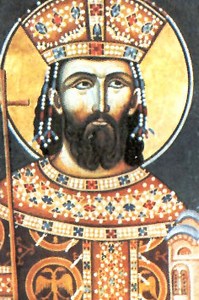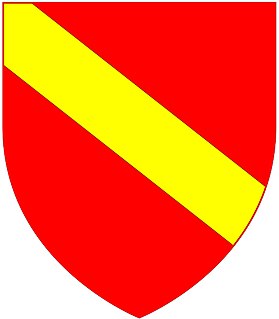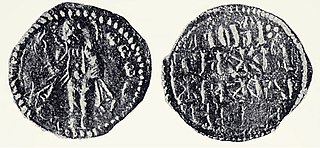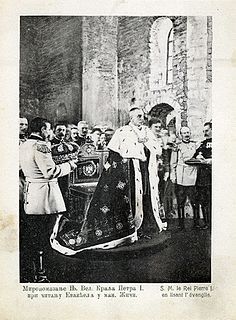Related Research Articles

Saint Stefan Uroš V, known in historiography and folk tradition as Uroš the Weak, was the second Emperor (Tsar) of the Serbian Empire (1355–1371), and before that he was Serbian King and co-ruler with his father, Emperor Stefan Dušan.

Stefan Nemanjić II, or Stefan the First-Crowned, was the Grand Prince of Serbia from 1196 and the King of Serbia from 1217 until his death in 1228. He was the first Rascian king; due to his transformation of the Serbian Grand Principality into the Kingdom of Serbia and the assistance he provided his brother Saint Sava in establishing the Serbian Orthodox Church, he is regarded one of the most important members of the Nemanjić dynasty.

Lazar Hrebeljanović was a medieval Serbian ruler who created the largest and most powerful state on the territory of the disintegrated Serbian Empire. Lazar's state, referred to by historians as Moravian Serbia, comprised the basins of the Great Morava, West Morava, and South Morava rivers. Lazar ruled Moravian Serbia from 1373 until his death in 1389. He sought to resurrect the Serbian Empire and place himself at its helm, claiming to be the direct successor of the Nemanjić dynasty, which went extinct in 1371 after ruling over Serbia for two centuries. Lazar's programme had the full support of the Serbian Orthodox Church, but the Serbian nobility did not recognize him as their supreme ruler. He is often referred to as Tsar Lazar Hrebeljanović ; however, he only held the title of prince.
Grand prince or great prince is a title of nobility ranked in honour below emperor, equal of king or archduke and above a sovereign prince.

The Vojislavljević was a Serbian medieval dynasty, named after archon Stefan Vojislav, who wrested the polities of Duklja, Travunia, Zahumlje, inner Serbia and Bosnia from the Byzantines in the mid-11th century. His successors, kings Mihailo I Vojislavljević and Constantine Bodin expanded and consolidated the state. During the 12th century, the main line of the Vojislavljević family was ousted by their cadet branch, the Vukanović, in the late 12th century.

Vukan Nemanjić was the Grand Prince of the Grand Principality of Serbia from 1202 to 1204. He was the Grand Prince of Pomorje from 1195 until his death. He was the eldest, but his father had instead chosen his younger brother Stefan as heir, as soon as his father died, he plotted against his brother, Stefan II Nemanjić, and took the throne by force, in a coup assisted by the Kingdom of Hungary. He was defeated two years later, and was pardoned by his third brother, who became Saint Sava, and he continued to rule his appanage of Zeta unpunished.
Grand, Great or Chief Župan is the English rendering of a South Slavic Serbian title which relate etymologically to Župan.
The Vukanović dynasty, was a medieval Serbian dynasty that ruled over inner Serbia, centered in the Raška region, during the 11th and 12th century. Several members of the Vukanović dynasty also ruled in some other regions. The house may have descended from the Vojislavljević dynasty of Duklja. Vukanović dynasty was later succeeded in Serbia by the closely related Nemanjić dynasty.
Tihomir of Serbia was the Grand Prince of the Grand Principality of Serbia (1166).

Between 1345 and 1371, the Serbian monarch was self-titled emperor (tsar). The full title was initially Emperor of the Serbs and Greeks, later Emperor of the Serbs and Greeks and Bulgarians in Serbian and basileus and autokrator of Serbia and Romania ["the land of the Romans"] in Greek. This title was soon enlarged into "Emperor and Autocrat of the Serbs and Greeks, the Bulgarians and Albanians". The Serbian Empire was ruled by only two monarchs; Stefan Dušan and Stefan Uroš V. Two other claimants of the title ruled in Thessaly, Central Greece.

Andrea Gropa was a 14th-century Albanian nobleman who ruled the region and the city of Ohrid, first as a minor vassal for a very short time (župan) to Serbian King Vukašin Mrnjavčević, then as independent after 1370. He was a rival to Prince Marko and together with Andrea II Muzaka managed to take Prilep and Kostur from him. He hailed from the noble Gropa family.

Grand Principality of Serbia, or Rascia, was a medieval Serbian state that existed from the second half of the 11th century up until 1217, when it was transformed into the Kingdom of Serbia. Initially, the Grand Principality of Serbia emerged in the historical region of Raška, and gradually expanded, during the 12th century, encompassing various neighboring regions, including territories of modern Montenegro, Herzegovina, and southern Dalmatia. It was founded by Grand Prince Vukan, who initially served as regional governor of Raška, appointed by King Constantine Bodin. During Byzantine-Serbian wars Vukan gained prominence and became self-governing ruler in inner Serbian regions. He founded the Vukanović dynasty, that ruled the Grand Principality. Through diplomatic ties with the Kingdom of Hungary, Vukan′s successors managed to retain their self-governance, while also recognizing the supreme overlordship of the Byzantine Empire, up to 1180. Grand Prince Stefan Nemanja (1166–1196) gained full independence and united almost all Serbian lands. His son, Grand Prince Stefan was crowned King of Serbia in 1217, while his younger son Saint Sava became the first Archbishop of Serbs, in 1219.
In the medieval Serbian states, the privileged class consisted of nobility and clergy, distinguished from commoners, part of the feudal society. The Serbian nobility were roughly grouped into magnates, the upper stratum, and the lesser nobility (vlasteličići). Serbia followed the government model established by the Byzantine Empire.

The Dejanović or Dragaš, originates from a medieval noble family that served the Serbian Empire of Dušan the Mighty and Uroš the Weak, and during the fall of the Serbian Empire, after the Battle of Maritsa (1371), it became an Ottoman vassal. The family was one of the most prominent during these periods. The family held a region roughly centered where the borders of Serbia, Bulgaria and North Macedonia meet. The last two Byzantine Emperors were maternal descendants of the house.
In the Medieval Serbian state, a range of court and honorific titles were used.
There has been many regnal styles of Serbian sovereigns.

The accession of the Serbian monarch was legitimised by a coronation ceremony, which was carried out by church officials.

Branko was a Serbian magnate who served to king and emperor Stefan Dušan, and emperor Stefan Uroš V, with the titles of sluga and later sevastokrator. A member of an old and respectable family, possibly descending from the Serbian dynasty itself, Branko began his royal service in the nearest circle of the ruler. After the elevation of the Serbian state to the Empire (1346), Branko received the second-highest court title, sevastokrator, usually given to relatives. He governed the Ohrid region. Branko had three sons and a daughter, of whom Vuk Branković would become an important person in the period of the Fall of the Serbian Empire.
References
- ↑ Fine 1991, p. 102
- ↑ Fine 1991, p. 141
- ↑ Francis William Carter; David Turnock (1999). The States of Eastern Europe. Ashgate. p. 252. ISBN 978-1-85521-512-2.
- 1 2 Сима Ћирковић; Раде Михальчић (1999). Лексикон српског средњег века. Knowledge. p. 73. ISBN 9788683233014.
ВЕЛИКИ ЖУПАН - 1. Титула српског владара у XI и XII веку. Гласила је велнм жупднк и била превођена одговарајућим терминима, грчки арџ- ^огтагот, игуа^огтауге, цеуаХа? ^огтожх, латин- ски те^ајирапиз, та§пиз ...
- ↑ Svetislav Mandić (1986). Velika gospoda sve srpske zemlje i drugi prosopografski prilozi. Srpska književna zadruga. p. 60. ISBN 9788637900122.
Велики краљ
- ↑ Veselinović, p. 45
- ↑ Konstantin Jirecek, Geschichte der Serben 1, Gotha 1911,p.289
- ↑ Miklošič 1858, p. 180, № CLXVII.
- ↑ Fine 1994, p. 393
- ↑ Mihaljčić 2001, pp. 78–115
- ↑ Jovan Ilić (1995). The Serbian question in the Balkans. Faculty of Geography, University of Belgrade. ISBN 9788682657019.
Prince Lazar is for Hungary the "Prince of the Kingdom of Rascia"
Sources
- Fine, John Van Antwerp (1994). The Late Medieval Balkans: A Critical Survey from the Late Twelfth Century to the Ottoman Conquest. Ann Arbor, Michigan: The University of Michigan Press. ISBN 0-472-08260-4.
- Mihaljčić, Rade (2001) [1984]. Лазар Хребељановић: историја, култ, предање (in Serbian). Belgrade: Srpska školska knjiga; Knowledge. ISBN 86-83565-01-7.
- Veselinović, Andrija (2006) [1995]. Држава српских деспота[State of the Serbian Despots]. Belgrade: Zavod za udžbenike i nastavna sredstva. ISBN 86-17-12911-5.
- Šarkić, S. (2012). "Vladarske titule u srednjovekovnoj Srbiji" [Monarch's titles in Mediaeval Serbia](PDF). Zbornik radova Pravnog fakulteta, Novi Sad. 46 (2): 23–35.